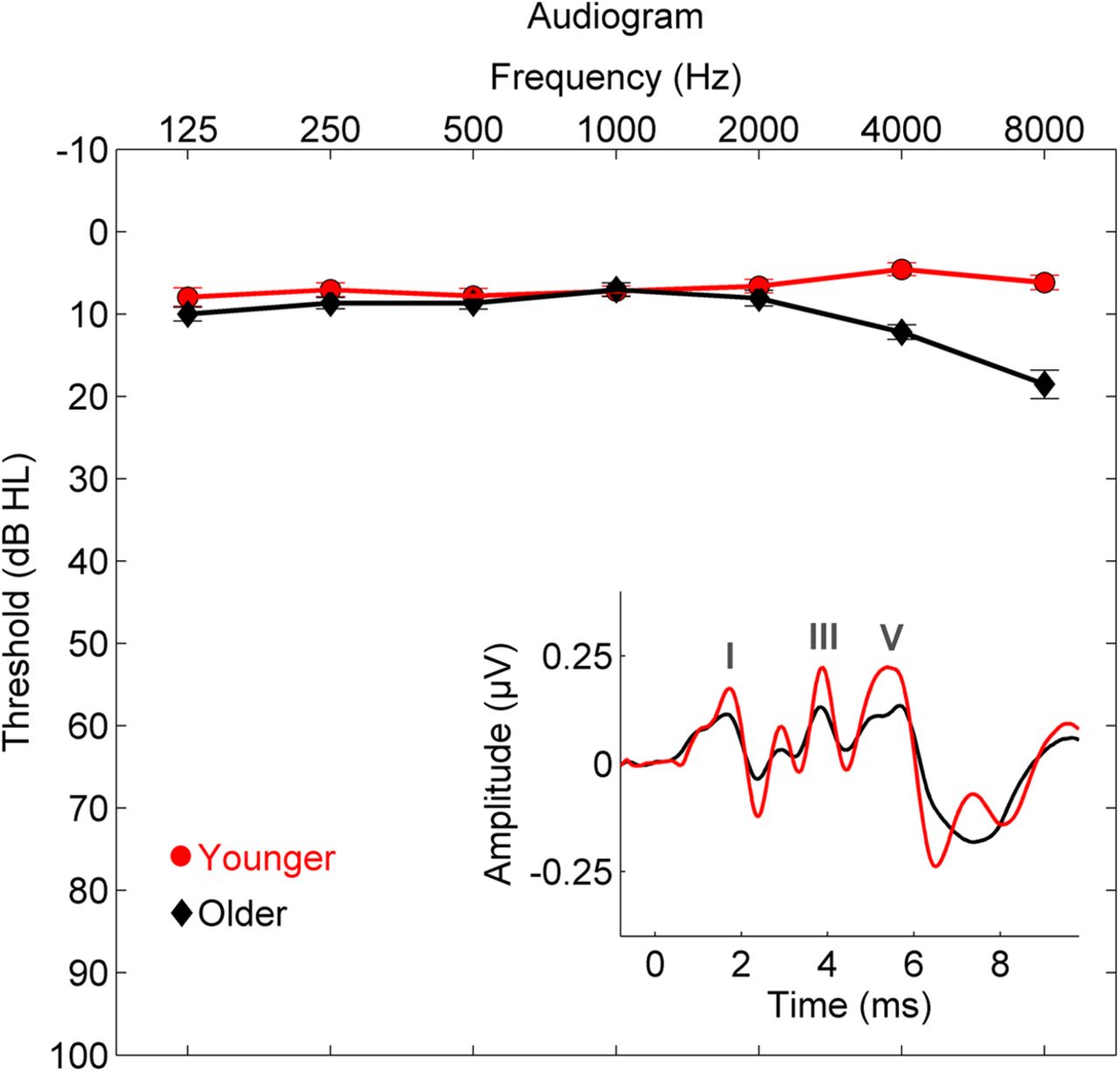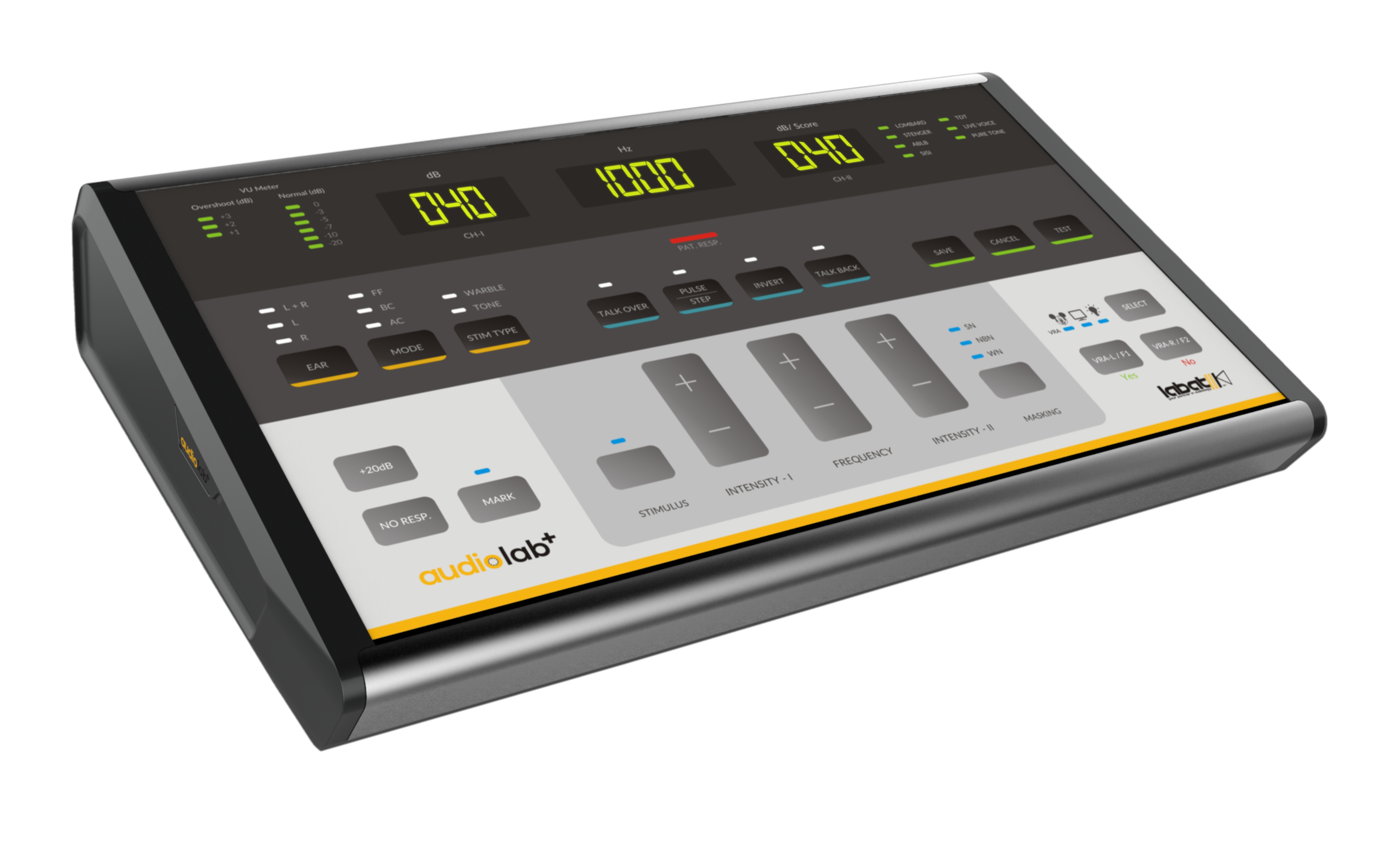|
Minimum Audibility Curve
Minimum audibility curve is a standardized graph of the threshold of hearing frequency for an average human, and is used as the reference level when measuring hearing loss with an audiometer as shown on an audiogram. Audiograms are produced using a piece of test equipment called an audiometer, and this allows different frequencies to be presented to the subject, usually over calibrated headphones, at any specified level. The levels are, however, not absolute, but weighted with frequency relative to a standard graph known as the minimum audibility curve which is intended to represent 'normal' hearing. This is not the best threshold found for all subjects, under ideal test conditions, which is represented by around 0 phon or the threshold of hearing on the equal-loudness contours, but is standardised in an ANSI standard to a level somewhat higher at 1 kH There are several definitions of the minimal audibility curve, defined in different international standards, and they diff ... [...More Info...] [...Related Items...] OR: [Wikipedia] [Google] [Baidu] |
Threshold Of Hearing
The absolute threshold of hearing (ATH) is the minimum sound level of a pure tone that an average human ear with normal hearing can hear with no other sound present. The absolute threshold relates to the sound that can just be heard by the organism.Durrant J D., Lovrinic J H. 1984. ''Bases of Hearing Sciences''. Second Edition. United States of America: Williams & WilkinsGelfand S A., 2004. ''Hearing an Introduction to Psychological and Physiological Acoustics''. Fourth edition. United States of America: Marcel Dekker The absolute threshold is not a discrete point, and is therefore classed as the point at which a sound elicits a response a specified percentage of the time. This is also known as the auditory threshold. The threshold of hearing is generally reported as the RMS sound pressure of 20 micropascals, i.e. 0 dB SPL, corresponding to a sound intensity of 0.98 pW/m2 at 1 atmosphere and 25 °C. It is approximately the quietest sound a young human with undamag ... [...More Info...] [...Related Items...] OR: [Wikipedia] [Google] [Baidu] |
Audiometry
Audiometry () is a branch of audiology and the science of measuring hearing acuity for variations in sound intensity and pitch and for tonal purity, involving thresholds and differing frequencies. Typically, audiometric tests determine a subject's hearing levels with the help of an audiometer, but may also measure ability to discriminate between different sound intensities, recognize pitch, or distinguish speech from background noise. Acoustic reflex and otoacoustic emissions may also be measured. Results of audiometric tests are used to diagnose hearing loss or diseases of the ear, and often make use of an audiogram. History The basic requirements of the field were to be able to produce a repeating sound, some way to attenuate the amplitude, a way to transmit the sound to the subject, and a means to record and interpret the subject's responses to the test. Mechanical "acuity meters" and tuning forks For many years there was desultory use of various devices capable of produc ... [...More Info...] [...Related Items...] OR: [Wikipedia] [Google] [Baidu] |
Pure Tone Audiometry
Pure-tone audiometry is the main hearing test used to identify hearing threshold levels of an individual, enabling determination of the degree, type and configuration of a hearing loss and thus providing a basis for diagnosis and management. Pure-tone audiometry is a subjective, behavioural measurement of a hearing threshold, as it relies on patient responses to ''pure tone'' stimuli. Therefore, pure-tone audiometry is only used on adults and children old enough to cooperate with the test procedure. As with most clinical tests, standardized calibration of the test environment, the equipment and the stimuli is needed before testing proceeds (in reference to ISO, ANSI, or other standardization body). Pure-tone audiometry only measures audibility thresholds, rather than other aspects of hearing such as sound localization and speech recognition. However, there are benefits to using pure-tone audiometry over other forms of hearing test, such as click auditory brainstem response (ABR). ... [...More Info...] [...Related Items...] OR: [Wikipedia] [Google] [Baidu] |
Psychoacoustics
Psychoacoustics is the branch of psychophysics involving the scientific study of sound perception and audiology—how humans perceive various sounds. More specifically, it is the branch of science studying the psychological responses associated with sound (including noise, speech, and music). Psychoacoustics is an interdisciplinary field of many areas, including psychology, acoustics, electronic engineering, physics, biology, physiology, and computer science. Background Hearing is not a purely mechanical phenomenon of wave propagation, but is also a sensory and perceptual event; in other words, when a person hears something, that something arrives at the ear as a mechanical sound wave traveling through the air, but within the ear it is transformed into neural action potentials. The outer hair cells (OHC) of a mammalian cochlea give rise to enhanced sensitivity and better frequency resolution of the mechanical response of the cochlear partition. These nerve pulses then travel to the ... [...More Info...] [...Related Items...] OR: [Wikipedia] [Google] [Baidu] |
Hearing (sense)
Hearing, or auditory perception, is the ability to perceive sounds through an organ, such as an ear, by detecting vibrations as periodic changes in the pressure of a surrounding medium. The academic field concerned with hearing is auditory science. Sound may be heard through solid, liquid, or gaseous matter. It is one of the traditional five senses. Partial or total inability to hear is called hearing loss. In humans and other vertebrates, hearing is performed primarily by the auditory system: mechanical waves, known as vibrations, are detected by the ear and transduced into nerve impulses that are perceived by the brain (primarily in the temporal lobe). Like touch, audition requires sensitivity to the movement of molecules in the world outside the organism. Both hearing and touch are types of mechanosensation. Hearing mechanism There are three main components of the human auditory system: the outer ear, the middle ear, and the inner ear. Outer ear The outer ear in ... [...More Info...] [...Related Items...] OR: [Wikipedia] [Google] [Baidu] |
Hearing Range
Hearing range describes the range of frequencies that can be heard by humans or other animals, though it can also refer to the range of levels. The human range is commonly given as 20 to 20,000 Hz, although there is considerable variation between individuals, especially at high frequencies, and a gradual loss of sensitivity to higher frequencies with age is considered normal. Sensitivity also varies with frequency, as shown by equal-loudness contours. Routine investigation for hearing loss usually involves an audiogram which shows threshold levels relative to a normal. Several animal species are able to hear frequencies well beyond the human hearing range. Some dolphins and bats, for example, can hear frequencies over 100 kHz. Elephants can hear sounds at 14–16 Hz, while some whales can hear infrasonic sounds as low as 7 Hz. Measurement A basic measure of hearing is afforded by an audiogram, a graph of the absolute threshold of hearing (minimum discer ... [...More Info...] [...Related Items...] OR: [Wikipedia] [Google] [Baidu] |
Equal-loudness Contour
An equal-loudness contour is a measure of sound pressure level, over the frequency spectrum, for which a listener perceives a constant loudness when presented with pure steady tones. The unit of measurement for loudness levels is the phon and is arrived at by reference to equal-loudness contours. By definition, two sine waves of differing frequencies are said to have equal-loudness level measured in phons if they are perceived as equally loud by the average young person without significant hearing impairment. The Fletcher–Munson curves are one of many sets of equal-loudness contours for the human ear, determined experimentally by Harvey Fletcher and Wilden A. Munson, and reported in a 1933 paper entitled "Loudness, its definition, measurement and calculation" in the ''Journal of the Acoustical Society of America''. Fletcher–Munson curves have been superseded and incorporated into newer standards. The definitive curves are those defined in ISO 226 from the International Orga ... [...More Info...] [...Related Items...] OR: [Wikipedia] [Google] [Baidu] |
A-weighting
A-weighting is the most commonly used of a family of curves defined in the International standard IEC 61672:2003 and various national standards relating to the measurement of sound pressure level. A-weighting is applied to instrument-measured sound levels in an effort to account for the relative loudness perceived by the human ear, as the ear is less sensitive to low audio frequencies. It is employed by arithmetically adding a table of values, listed by octave or third-octave bands, to the measured sound pressure levels in dB. The resulting octave band measurements are usually added (logarithmic method) to provide a single A-weighted value describing the sound; the units are written as dB(A). Other weighting sets of values – B, C, D and now Z – are discussed below. The curves were originally defined for use at different average sound levels, but A-weighting, though originally intended only for the measurement of low-level sounds (around 40 phon), is now commonly used for ... [...More Info...] [...Related Items...] OR: [Wikipedia] [Google] [Baidu] |
Audiology
Audiology (from Latin , "to hear"; and from Greek , ''-logia'') is a branch of science that studies hearing, balance, and related disorders. Audiologists treat those with hearing loss and proactively prevent related damage. By employing various testing strategies (e.g. behavioral hearing tests, otoacoustic emission measurements, and electrophysiologic tests), audiologists aim to determine whether someone has normal sensitivity to sounds. If hearing loss is identified, audiologists determine which portions of hearing (high, middle, or low frequencies) are affected, to what degree (severity of loss), and where the lesion causing the hearing loss is found (outer ear, middle ear, inner ear, auditory nerve and/or central nervous system). If an audiologist determines that a hearing loss or vestibular abnormality is present, they will provide recommendations for interventions or rehabilitation (e.g. hearing aids, cochlear implants, appropriate medical referrals). In addition to diagn ... [...More Info...] [...Related Items...] OR: [Wikipedia] [Google] [Baidu] |
Audiometer
An audiometer is a machine used for evaluating hearing acuity. They usually consist of an embedded hardware unit connected to a pair of headphones and a test subject feedback button, sometimes controlled by a standard PC. Such systems can also be used with bone vibrators, to test conductive hearing mechanisms. Audiometers are standard equipment at ENT (ear, nose, throat) clinics and in audiology centers. An alternative to hardware audiometers are software audiometers, which are available in many different configurations. Screening PC-based audiometers use a standard computer. Clinical PC-based audiometers are generally more expensive than software audiometers, but are much more accurate and efficient. They are most commonly used in hospitals, audiology centers and research communities. These audiometers are also used to conduct industrial audiometric testing. Some audiometers even provide a software developer's kit that provides researchers with the capability to create their ... [...More Info...] [...Related Items...] OR: [Wikipedia] [Google] [Baidu] |
Audiogram
An audiogram is a graph that shows the audible threshold for standardized frequencies as measured by an audiometer. The Y axis represents intensity measured in decibels and the X axis represents frequency measured in hertz. The threshold of hearing is plotted relative to a standardised curve that represents 'normal' hearing, in dB(HL). They are not the same as equal-loudness contours, which are a set of curves representing equal loudness at different levels, as well as at the threshold of hearing, in absolute terms measured in dB SPL (sound pressure level). Audiograms are set out with frequency in hertz (Hz) on the horizontal axis, most commonly on a logarithmic scale, and a linear dBHL scale on the vertical axis. For humans, normal hearing is between −10 dB(HL) and 15 dB(HL), although 0 dB from 250 Hz to 8 kHz is deemed to be 'average' normal hearing. Hearing thresholds of humans and other mammals can be found with behavioural hearing tests or physi ... [...More Info...] [...Related Items...] OR: [Wikipedia] [Google] [Baidu] |





